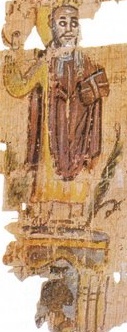Theophilus I of Alexandria facts for kids
Quick facts for kids Saint Theophilus of Alexandria |
|
|---|---|
| Pope of Alexandria and Patriarch of the See of Saint Mark | |

Theophilus atop the Serapeum, depiction from the Alexandrian World Chronicle
|
|
| Papacy began | 384 |
| Papacy ended | 15 October 412 |
| Predecessor | Timothy I |
| Successor | Cyril "Pillar of Faith" |
| Personal details | |
| Died | 15 October 412 |
| Buried | Dominicium, Alexandria |
| Nationality | Egyptian |
| Denomination | Church of Alexandria |
| Residence | Saint Mark's Church |
| Sainthood | |
| Feast day | 18 Paopi (Coptic calendar) 15 October (Julian calendar) Currently 28 October (Gregorian calendar) |
| Venerated in | Coptic Orthodox Church and Syriac Orthodox Church |
Theophilus (whose name in Greek was Θεόφιλος) was an important religious leader. He was the 23rd Pope of Alexandria and also the Patriarch of the Seat of Saint Mark. This means he was the head of the Christian Church in Alexandria, a major city in ancient Egypt.
Theophilus became pope during a time of big changes. Christians were becoming more powerful, and there were still many people who followed older pagan religions. These two groups often disagreed, and Theophilus played a key role in these conflicts.
The Serapeum and Religious Changes
In the year 391 AD, Theophilus found a hidden pagan temple. This temple was part of the Serapeum, a famous and important building dedicated to the god Serapis. Theophilus and his followers showed the pagan statues and items to the public. This made the pagans very angry, and they attacked the Christians.
The Christians fought back, and the pagans had to hide inside the Serapeum. The Roman Emperor sent a letter saying that Theophilus should forgive the pagans. However, the Emperor also said that the temple should be destroyed. This destruction was something Theophilus had strongly asked for.
Many people, both then and now, saw the destruction of the Serapeum as a symbol. It showed that Christianity was becoming the main religion. Later, when the philosopher Hypatia was killed, people praised Theophilus's nephew, Cyril. They said Cyril was "the new Theophilus" because he had helped remove the last signs of the old religions in the city.
Conflicts and Church Politics
Theophilus sometimes changed his mind about who he supported. For a while, he supported followers of a thinker named Origen. But then he changed his views about God. He started to agree with local monks who believed God had a human-like form. This was different from Origen's view that God was without a physical body.
In 403 AD, Theophilus traveled to Constantinople with his nephew Cyril. There, he led a meeting called the "Synod of the Oak". At this meeting, they removed John Chrysostom from his position as Patriarch of Constantinople.
Theophilus also had strong disagreements with some monks who followed Origen's ideas. He took action against them, which led to many monks being persecuted.
Writings and Legacy
Theophilus wrote many letters and sermons. Some of his writings include:
- Letters he exchanged with other important church leaders like Jerome and two Popes, Pope Anastasius I and Pope Innocent I.
- A work called the "Vision of Theophilus".
- Sermons, some of which were translated by Jerome.
- Other sermons that can only be found in Coptic and Ge'ez translations.
Theophilus is remembered in different ways by different Christian churches. He is considered a saint by the Coptic Church of Alexandria. However, he is not recognized as a saint by the Eastern Orthodox, Roman Catholic, or Assyrian Churches.
A crater on the Moon, called Theophilus, was named after him. It is one of three lunar craters named after important Christian leaders from Alexandria.

